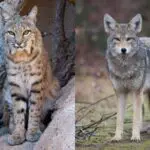The mountain lion and a coyote are two drastically different animals.
The primary difference between them is the fact that the mountain lion is a large cat, whereas a coyote is a canine, or dog.
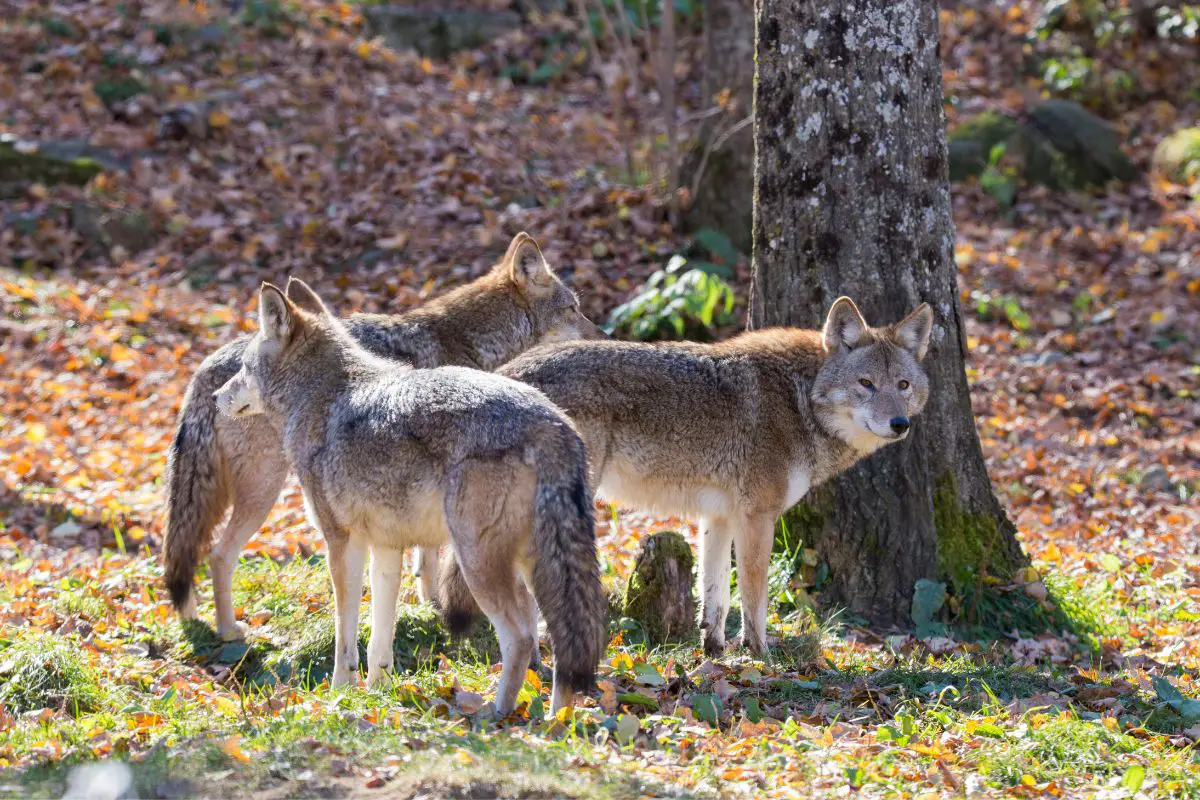
Coyotes are also a lot smaller than mountain lions, and live in family groups.
Mountain lions go by many names, and even have the record for the most English names.
They are called pumas, cougars, catamount, and many other names. There are six living subspecies of mountain lions, and one extinct subspecies – the Eastern mountain lion.
Coyotes, on the other hand, have 19 different subspecies. While all of these subspecies are similar, some are larger than others and have different coloring.
These subspecies are found throughout North and Central America, but do not occur naturally in South America.
To find out more about the differences between mountain lions and coyotes, keep reading.
Mountain Lion Vs Cayote: The Main Differences
Classification
Mountain Lion
- Also known as: puma, cougar, panther, catamount, red tiger, deer tiger, painter
- Average lifespan in the wild: 10-13 years
- Scientific name: puma concolor
- Genus: Puma
- Family: Felidae
- Order: Carnivora
- Class: Mammalia
- Kingdom: Animalia
- Phylum: Chordata
- Height: 2-3 feet at the shoulder
- Weight: 64-220 lbs
- Length: 3.25-5.25 feet (head and body); 23.5-33.5 inches (tail)
- Conservation status: varies depending on subspecies, typically least concern (population decreasing)
- Number of subspecies: seven living subspecies, one extinct
Coyote
- Also known as: prairie wolf; brush wolf; cased wolf; American jackal; little wolf
- Average lifespan in the wild: 10-14 years
- Scientific name: Canis latrans
- Genus: Canis
- Family: Canidae
- Order: Carnivora
- Class: Mammalia
- Kingdom: Animalia
- Phylum: Chordata
- Height: 24 inches at the shoulder
- Weight: 18-44 lbs
- Length: 3.3-4.3 feet
- Conservation status: least concern
- Number of subspecies: 19
Appearance And Characteristics
Mountain Lion
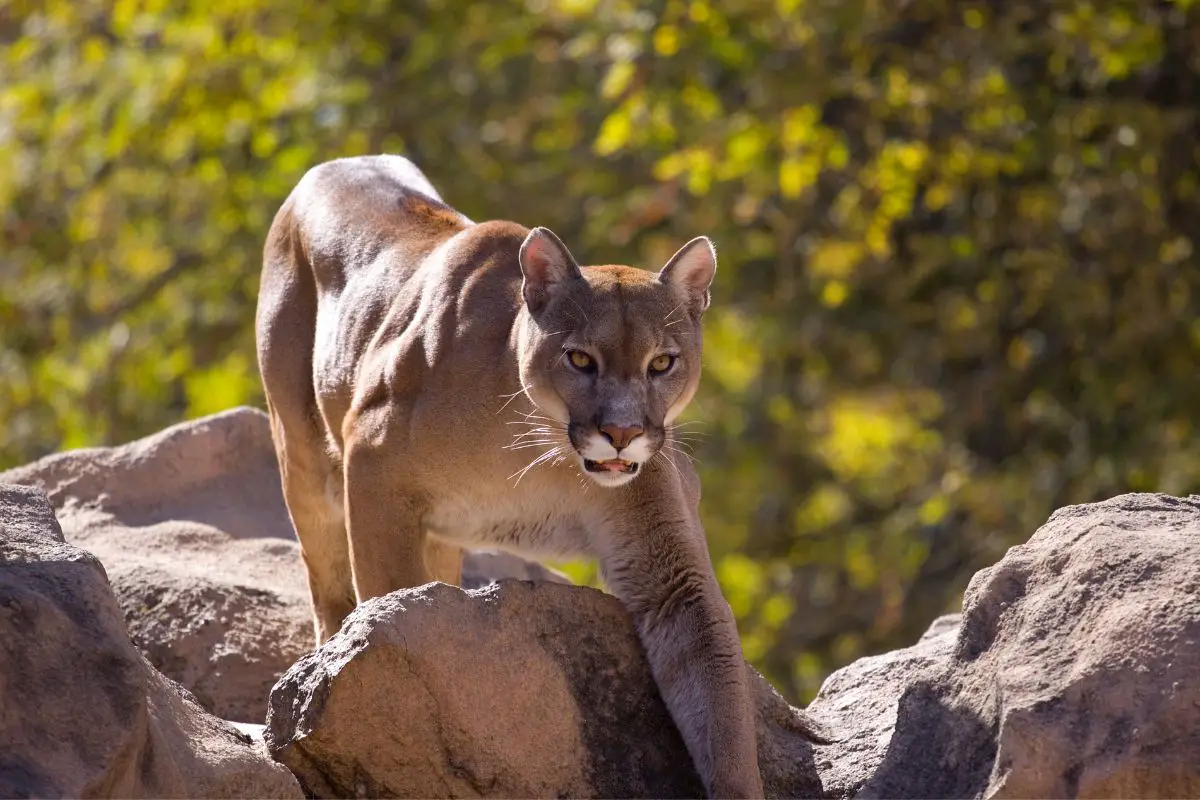
The mountain lion is a large, tan cat with a white or gray belly and chest. Their color can vary slightly depending on where in the Americas they are.
However, they will always be a shade of tan or a tawny brown unless they have a mutation.
Some mutations can cause animals, including mountain lions, to be black, white, or mixed variation.
Besides their recognizable tawny coloring, a mountain lion will also have a few black markings.
These markings will be around the animal’s snout, the tips of their ears, and the tip of their tail. Adults have eyes that can appear to be a green-brown or yellow color.
This coloring will eventually appear when the animal is about a year and a half old.
Mountain Lion cubs have a very different appearance from their parents.
They are covered in black spots to help them blend into their surroundings, but have the same tan or tawny colored fur as their parents.
Compared to adults, the young have more black on them. This black is visible on their faces, including their snout and above their eyes.
Cubs also have blue eyes that change color as they get older.
Typically, the larger animals are closer to the poles and will be in counties like Alaska and Argentina or Chile.
Closer to the equator, in countries like Colombia, Ecuador, and Brazil, mountain lions are usually smaller.
These animals typically only reach lengths of around 5 feet, and their tails are between 23 and 33 inches long.
So, from nose to the tip of the tail, a mountain lion can measure up to 7.7 feet long. Up to the shoulder, these lions can measure up to a maximum of three feet, and they can weigh up to 220 lbs.
It should be said that the majority of mountain lions will be slightly smaller, as these numbers are on the upper limit.
Females are also smaller than males. The females are more likely to weigh up to 120 lbs, and are generally about ⅓ smaller than the males.
Coyote
Coyotes look much like domesticated dogs or smaller versions of wolves.
Their coloring can vary depending on the subspecies and location, but are typically a mixture of browns and grays.
Some subspecies have reddish tones in their fur, which indicates their cross-breeding with red wolves.
These animals have large triangular ears and golden brown eyes. However, some coyotes have been reported to have blue eyes, though this is extremely rare.
They have a long, fluffy tail, much like a German Shepherd. In terms of size, coyotes typically grow to only 24 inches at the shoulder and are between 3.3 and 4.3 feet long.
They only weigh in between 18-44 lbs, which is considerably smaller than a mountain lion.
Coyote pups are incredibly fluffy and resemble chihuahuas. They have no noticeable markings.
Sounds And Calls
Mountain Lion
Mountain lions can make a range of sounds, but they can’t roar like lions or tigers.
A mountain lion will growl and hiss, like a house cat, and they can also purr.
Males and females are known for their “scream” that can often be heard in the wilderness.
This scream is loud and shrill, and resembles a woman’s scream very closely. In fact, the two are often mistaken for each other.
This scream is the most well-known sound of a cougar. This sound is something that you should always look out for if you are out.
For female cougars, this scream is thought to indicate that they are ready to mate and is done to signal that to males in the area.
If you hear something that sounds like a screaming woman in the wild, you should move in the opposite direction.
Cougar cubs can hiss and make chirping sounds. This chirping is thought to be a way of them locating their mother, and the mother will chirp back.
Coyote
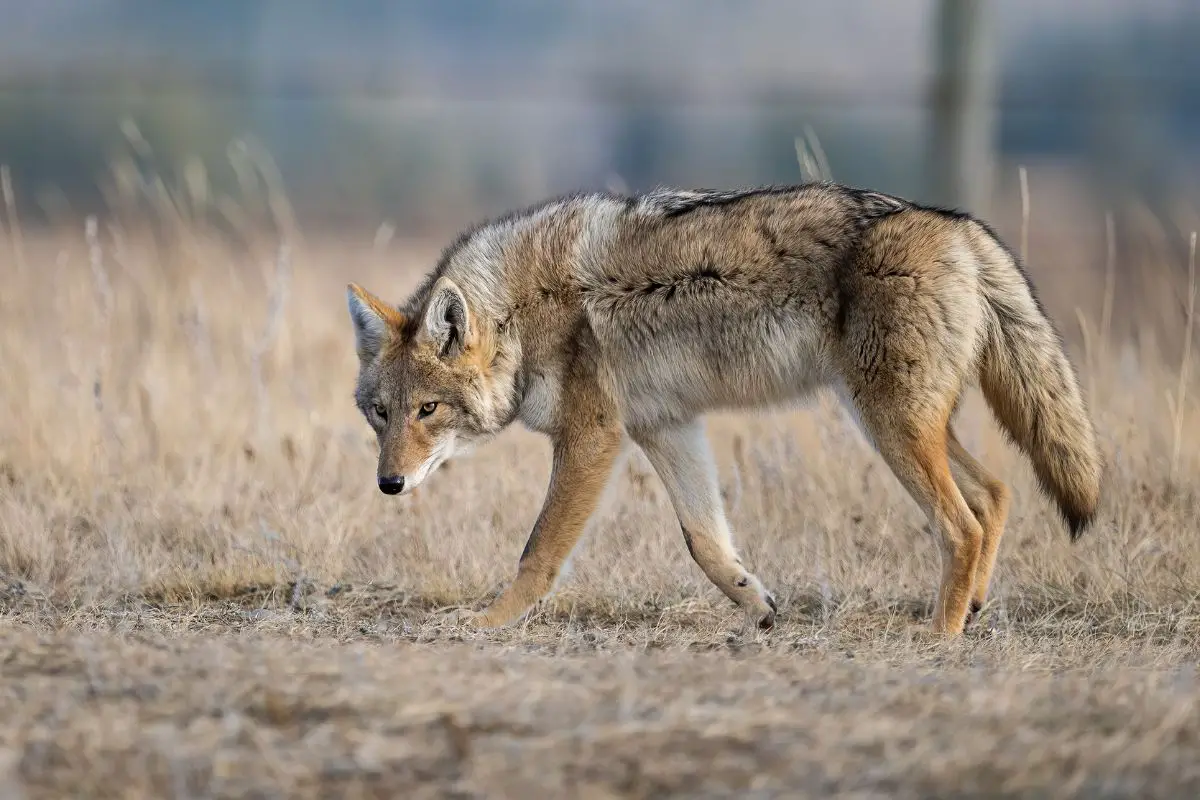
Coyotes can make a range of sounds, including howling, growling, yipping, and laughing.
If you came across a coyote, or there was a coyote pack near, you may expect to hear whining, barking, and laughing, too.
A coyote that is whining may be injured, or they are simply being submissive to another coyote.
Barking is used as a warning for other animals that enter the coyote’s territory.
One of the more unusual sounds from a coyote would be screaming – this is often employed if they are responding to a predator bigger than them – like a mountain lion or wolf.
In order to respond to a threat, a coyote will typically either yip or growl.
These are relatively common sounds that you may have heard when you were out on the trail.
Family
Mountain Lion
The mountain lion is part of the Felidae family, meaning that it is a cat.
Coyote
Coyotes are part of the Canidae family, which means that they are dogs.
Habitats And Range
Mountain Lion
Mountain lions cover an extreme range – all the way from Alaska to Argentina and even southern Chile.
Because of this, they can thrive in a variety of ecosystems as long as there is prey and shelter at their disposal.
It would not be unusual to see mountain lions anywhere from mountainous regions to deserts, forests, and wetlands.
No matter where they are, cougars typically prefer to stay away from humans and too much development.
There have been instances, however, where mountain lions are seen close to cities, or in city suburbs.
Coyote
Coyotes are also known to thrive in a variety of habitats. Some subspecies live in forests, while others live in prairies and deserts.
Generally, these animals will do well wherever there is enough food and shelter for them.
In terms of range, coyotes have actually expanded their range over the years.
They used to be confined to parts of the United States and Central America, but now can be found as far north as Alaska.
These animals are commonly found in places like the Great Plains, where they thrive in family groups.
While they used to range the Appalachians, coyotes are now found all over North America.
Social Behavior
Mountain Lion
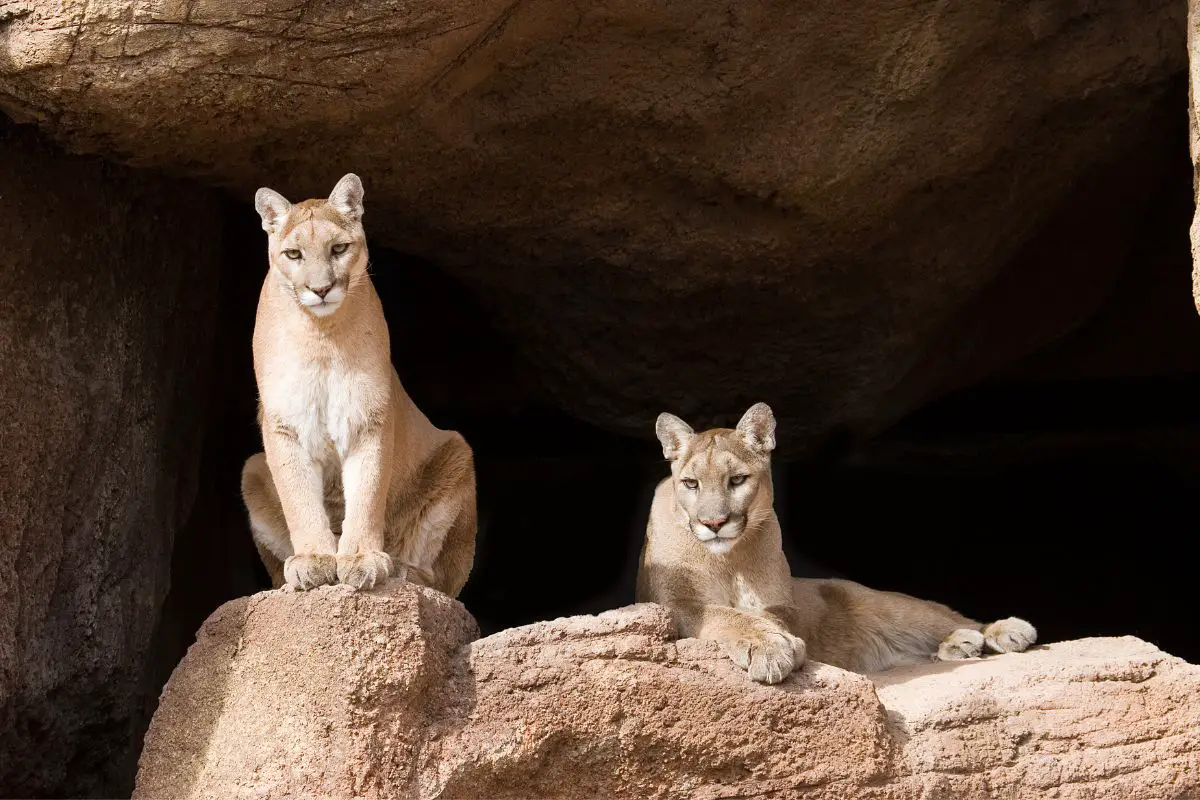
Mountain Lions are solitary animals. This means that they live alone and have their own territories.
The only time that these animals don’t live alone is during the mating season and when the female is caring for her cubs.
When solitary, these animals need between 50 and 125 square miles to roam, with males preferring more space.
Coyote
Coyotes like in large family groups. However, they will often wander or go hunting on their own or in pairs.
Territories are typically small, ranging only from 4-15 square miles. However, territory sizes can vary depending on how much prey is in the area.
Diet
Mountain Lion
Mountain lions are obligate carnivores, like all other cats. This means that they can only get the nutrients they need from meat rather than vegetation.
This does not mean that they cannot eat other food types, but simply that they would not get the benefit of doing so except for the pleasure of it or the flavor.
Mountain lions will typically hunt for things like deer or sheep, but will also eat smaller animals like mice and rabbits when available.
Coyote
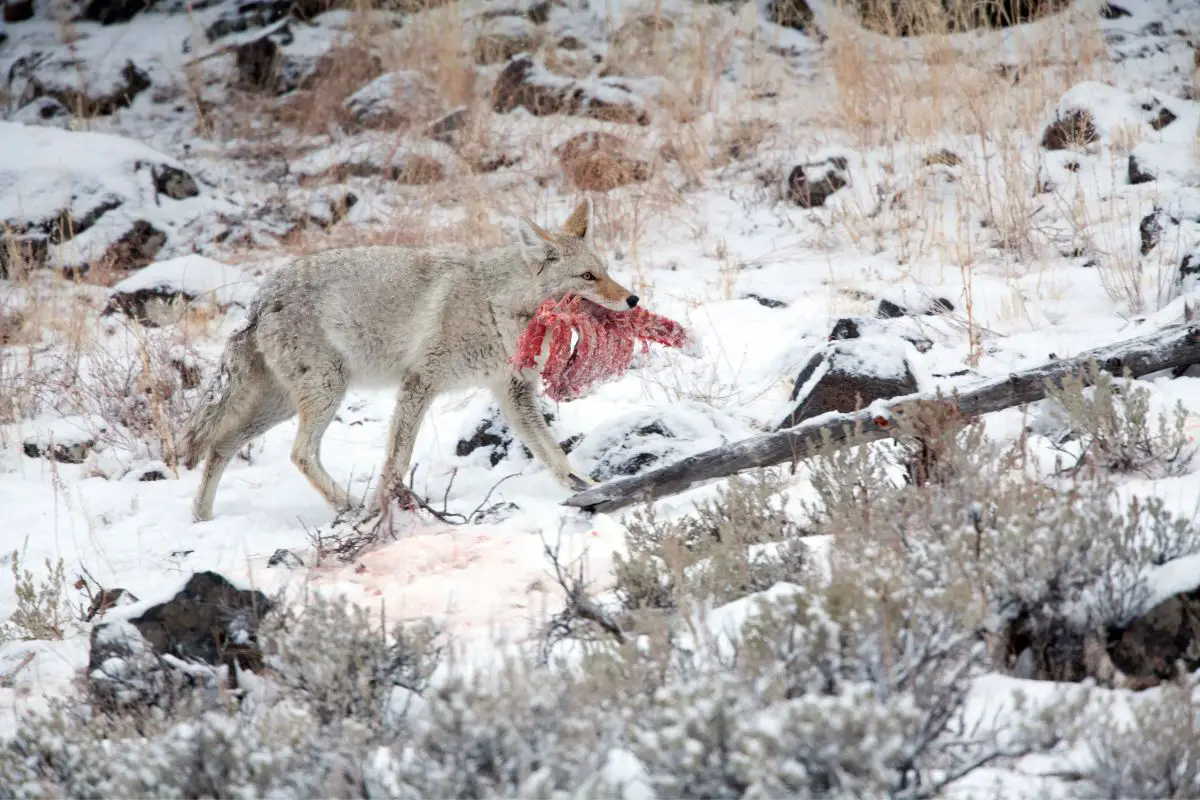
Like other canids, coyotes are technically omnivores. They primarily eat meat, either from carrion or their own hunts.
They are also known to eat anything they can get their paws in, including leftovers from trash cans and.
Coyotes will eat anything from mice and birds to larger prey if they can hunt it.
Because they are omnivores, they will also fill in the gaps of their diet with vegetation and fruits.
These animals have been known to enjoy fruits like apples and strawberries.
Breeding
Mountain Lion
Unlike many other animals, there is no set breeding or mating season for mountain lions. Mating can happen at any time of year.
However, the majority of mountain lion births take place in the late winter or early spring, but this is certainly not always the case. Females will breed every two years.
These animals have a gestation period of 90 to 96 days. When the mother is ready, she will typically give birth to anywhere between 1-5 cubs.
These cubs will then stay with her until they are ready to live on their own. This is usually until they are around 15 months, or little over a year old.
However, some cubs will stay with their mother until they are over two years old before venturing off on their own.
Coyote
Coyotes will typically mate between January and March. Their gestation period is between 58-65 days, then a female will give birth to a litter of 4-7 pups.
They give birth in underground burrows, and after 203 weeks, the pups will begin to emerge and play.
These animals usually only breed once a year, and both males and females reach sexual maturity when they are 12 months old.
Once mature, it isn’t unusual for coyotes to breed with wolves or domesticated dogs.
The offspring of coyotes and domestic dogs can look remarkably similar, and cross-breeding often results in hardy and strong animals.
However, because coyotes are not domesticated, cross-breeding is not seen as a good thing.
Who Would Win In A Fight – A Mountain Lion Or A Coyote?
A mountain lion would without a doubt win against a single coyote.
However, if a pack of coyotes were to attack a mountain lion, they would stand a good chance of success. After all, numbers can win the game.
The mountain lion may get overwhelmed by the sheer number of animals.
However, with that being said, the mountain lion would likely easily be able to escape.
If escape wasn’t an option, then it’s entirely possible that a pack of coyotes could take down a mountain lion, but a lone one never could.
Final Thoughts
Mountain lions and coyotes are very different animals. The mountain lion is a type of large cat, and is an obligate carnivore, while the coyote is a medium-sized dog and omnivorous.
Both animals are known for their hunting skills, but mountain lions typically take on much larger prey and are much stronger and more agile.
Overall, despite there being so many differences between these two animals, they also have their similarities if you study them closely enough.
- Sink Your Teeth Into This: Analyzing the Powerful Lion Bite Force - September 8, 2023
- Siberian Tigers: Everything You Need To Know - September 4, 2023
- Do Lions Eat Humans? Understanding Lion Aggression and Risks - September 4, 2023




